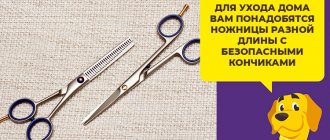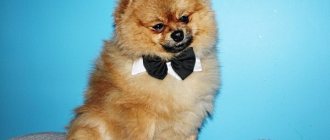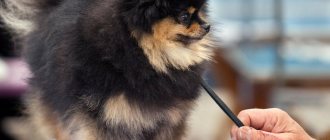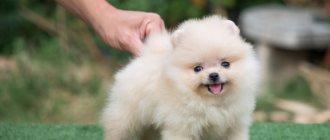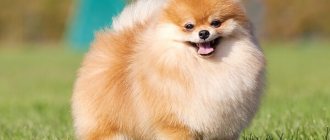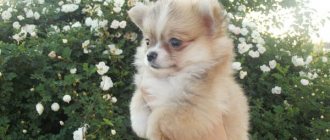Spitz development by month: how the height and weight of puppies changes
Those who understand the breed are interested in how much a Spitz can weigh or how tall it is. These are the distinctive features of the German Spitz varieties. The dog's exhibition career depends on these data. Therefore, the exterior indicators deserve special attention.
In today's review article we will find out how much puppies weigh at birth and how these numbers change as they grow older.
Characteristics of Spitz
The German Spitz breed is divided into several subspecies, differing from each other in their characteristic features. Small-sized dogs have a small head with a fox-like expression. The nose is somewhat elongated, the eyes resemble small black buttons. Erect ears visually make the rounded skull larger.
There are about 12 different colors allowed by the standard. After the baby's down changes, the real color of the coat appears - shedding occurs at about 6 months. The most popular and in demand are the red colored ones. There are pure black, black and tan, cream, sable, two-tone and white Pomeranians. The latter appeared not so long ago, because it is quite difficult to breed a pure white animal. This can also be applied to black individuals. When mating, special attention is paid to color. The correct combination of coat color is necessary to ensure that there are no unexpected “surprises” in the litter.
The most common variety is the dwarf (Pomeranian) Spitz. In another way they are also called miniature spitz. They owe their popularity to their miniature size. The fluffy lumps look like little bear cubs that have seduced a huge number of human hearts.
RKF breed standard
At first, Spitz dogs were classified as a working breed; they were kept to guard premises and things, exterminate rodents, and move cargo. In the Middle Ages, noble people liked the cute appearance and active nature of animals. This breed included Spitz-like babies who weighed more than 15 kilograms, but there were no breed standards. Spitz were named as a separate species only at the end of the 19th century, when the Amateur Club opened in Great Britain, and during the same period the initial standards were drawn up.
In the 19th century, dogs came to America, and in Europe only the nobility owned kennels. In Tsarist Russia, dogs were actively bred before the revolution, but they practically became extinct after the Great Patriotic War. The restoration of the population began at the end of the 20th century, when it was recognized by all canine organizations.
Pomeranians are not identified as a separate breed by specialists of the International Cynological Federation (FCI) and the Russian Cynological Federation (RKF). In the USA, this type of breed is a separate subspecies, and in the world and Russia it is classified as a dwarf variety of German Spitz (Zwerg). The standards of miniatures in European and American countries differ significantly, so photographs of dwarf individuals are different in different regions. It is necessary to select and evaluate a dog, given that Russian breeders rely on the FCI exterior.
According to the RKF, the Dwarf Pomeranian is the smallest German Spitz; similar features of several dogs of this subspecies include:
- strong bones;
- mobility;
- compactness;
- the presence of a fox muzzle;
- tail curled over the back;
- thick undercoat;
- standing guard hair.
The coat of oranges is thick, with abundant but soft undercoat. A distinctive feature of the pet is the presence of decorative elements of fur, which in the neck area is similar to a lion's collar. They have wool pants on their hips, and velvet hairs are located on their muzzle, ears, toes and feet.
According to the RKF breed standard, the Pomeranian Spitz has several types of shades:
- black;
- black and tan;
- silver gray;
- zonal;
- brown;
- ginger;
- orange;
- cream;
- cream sable;
- white;
- spotted.
A dwarf Spitz with a solid color is characterized by uniform color, with no lightened or darkened parts. For a dog to be entered into a dog show, its body weight is 1.4-3.2 kilograms, depending on its gender. An ideal Pomeranian weighs 1.8-2.3 kilograms, with body weight corresponding to height.
Distinctive features of the breed are harmony, density, strength of physique. Spitz paws are of medium length, distributed in proportion to the body to provide stability. The ideal proportion between the length and height of the body is 1 to 1, so the body looks like a square.
The body of Pomeranians is round, the chest is not voluminous, but quite deep. The wedge-shaped fox head is proportional to the canine body. The standards allow for medium-sized eyes of a dark coffee shade, located close to each other. A healthy pet has shiny eyes, and breeds with blue or brown fur are characterized by a lack of pigmentation around the eyes.
Small triangular ears are located close to each other and stand constantly. The skull is medium in size; it tapers towards the tip of the nose and has a pronounced transition from the muzzle to a rounded, voluminous forehead.
The Spitz's muzzle is extremely thin, the length of the skull in relation to the muzzle has a ratio of 1 to 2. Rounded cheekbones cannot protrude, and the small round nose is black. The exception is the brown Pomeranian type, since their nose is dark brown. According to the standard, a dog has 42 teeth in its mouth; premolars may be missing, but not all. The bite should be a scissor bite, but one protruding tooth is not considered a flaw. If the entire jaw protrudes, this is a defect.
The body of the Pomeranian Spitz is rounded, the dog is stocky, its ribs are well developed and rounded. The belly of a thoroughbred animal is tucked, and the skin does not form folds and fits tightly to the body. The straight, powerful back is well developed, small, and has:
- oblique shoulder blades;
- strong arched loin.
The dog's neck is thrown back at the shoulders, continuing the straight line of the back. It looks small because it is hidden under a fluffy thick undercoat. The animal's tail is its distinctive feature; it resembles a donut, the tip of which is curled over the back. The male is distinguished by the presence of two well-developed testicles, completely descended into the scrotum.
OLYMPUS DIGITAL CAMERA
The dog's body is perfectly balanced, distinguished by straight forelimbs of medium length, standing proportionally in relation to the body. The shoulders fit tightly to the sternum, they are almost similar in length. The elbows are pressed to the sternum, but not close together, and have well-developed elbow joints. Strongly built forearms are of medium length and straight in shape. Strong pasterns are located at a twenty-degree angle relative to the vertical. The paws of a purebred animal are similar to those of a cat:
- small in size;
- round shape;
- half-bent fingers;
- with neat fingers of equal length.
According to the description of experts, the femur is similar in length to the tibia. There are dewclaws on the paws, which should be surgically removed in a timely manner.
How much does a Pomeranian weigh at birth?
A competent breeder approaches the birth of a dog responsibly. When puppies are born, you always have a kitchen scale, a pen and a notepad at hand. The newborn baby must be weighed, the data recorded and then the dynamics of weight gain monitored. This is necessary so that the breeder can assess the development of the puppy. Miniature Pomeranians weigh approximately 85 g at birth, while larger ones can weigh around 170 g.
What determines the weight and size of puppies?
The development of a puppy is an individual matter. Every dog develops differently. This depends on certain factors:
- Heredity. Large parents often produce heavy puppies. Therefore, if the baby exceeds the standard, you should familiarize yourself with his pedigree;
- Nutrition. Even if born with a normal weight, a puppy can actively gain extra pounds if it is overfed. Or, conversely, it may lag behind the standard;
- Vitamin supplements. For proper growth and development during the period of active formation, the puppy must receive the necessary nutrients;
- Hyperactivity. Long active walks affect the development of the dog’s muscle corset, which also adds weight.
Spitz development and weight by month table
The table shows the development of the puppy by month.
| Age | Weight, g | |||
| Birth | 85 | 125 | 150 | 170 |
| 1 month | 280 | 450 | 600 | 670 |
| 2 months | 450 | 680 | 910 | 1050 |
| 3 months | 625 | 995 | 1270 | 1440 |
| 4 months | 850 | 1250 | 1600 | 1800 |
As the baby grows, his appearance changes along with his height and weight.
Differences in the sizes of different subspecies of adult Spitz
There has already been talk about varieties within the breed. Now let's look at it in more detail.
Mini
The height of a miniature Spitz is 18-22 cm, weight is about 3.2 kg. They are called Pomeranians or Miniature Spitz. The fur of small dogs is incredibly soft, fluffy, and medium length. This coat makes the dog look like a soft toy. There are red, cream, sable, black and white representatives of the breed. Average life expectancy is 10 years.
Small
Small Spitz cannot be called large, but they are much larger than Pomeranians. The height of a small Spitz does not exceed 29 cm, and body weight is 10 kg. On average, pets live about 14-15 years.
A distinctive breed feature of the variety is a wedge-shaped head with a wide skull. The ears are medium-sized and set high. The oval-shaped eyes are dark colored. Long coat with well-developed undercoat. The colors are similar to the previous type.
Average
The medium-sized variety is called "Middle Spitz". The size of an adult is 30-38 cm, weight is up to 11 kg. It is better to choose such dogs for people who have enough free time to provide their pets with long, active walks. These Spitz dogs have a hard time sitting still. It is best to train them from puppyhood, regardless of the size of the breed. After all, even decorative dogs need education and training. The average life expectancy of a pet is 13-15 years.
The dog's body has a somewhat square format. The body parts fit together in the correct proportions. The muzzle is large and has a rounded shape. Almond-shaped eyes are dark colored. Small ears are set high on the head. The medium-sized fluffy tail, similar to other varieties, is curved in the shape of a ring. The most common colors are solid, but representatives of the breed are found in black and tan and black and white colors.
Large
The largest representative of the German Spitz reaches a height of 55 cm and a weight of 30 kg. Large Spitz are divided into Gross Spitz and Keeshond. The first type comes only in a single color. Keeshodny – zone-gray. This is their only possible color. On average they live 15-18 years.
RKF classification
Russian Cynological Federation
The Russian Kynological Federation (RKF) places the Spitz in the fifth group according to the dog classification standard.
The fifth group is divided into sections into which varieties of oranges are placed:
- The second group includes: Finnish Spitz, Norrbotten Spitz;
- The fourth section includes the German Spitz;
- The fifth includes the Japanese Spitz, Chow Chow.
The Spitz breed standard is determined by the following parameters:
- Character;
- Smooth behavior and movements;
- Wool color;
- Trimmin;
- Density of undercoat;
- Paw structure;
- Pet's fatness;
- Proportionality of the body, body, head and paws;
- Body type.
You can follow trends in the development of standards on the Internet on specialized websites.
German Spitz
The German Dwarf Spitz is a popular variety of Spitz. Its history goes back more than one century. It is divided into four subspecies:
- Classical;
- Fox;
- Chow-chow;
- Pomeranian.
The classic Spitz has a well-built body and medium hair. The dog's skull and muzzle meet the standards: the fossa between the muzzle and the skull is small, the proportions of the skull to the muzzle are 4 to 2.
The muzzle occupies one third of the length of the skull. The tail is thrown behind the back.
The Fox breed lives up to its name. Its representatives resemble a fox. The muzzle is slightly pointed, unlike representatives of other breeds. The coat is lush. The length of the muzzle to the skull is 2 to 3.
Fingers and paws are extended. The tail has the shape of a ring. The most common Fox color is red.
The Chow Chow is a compact type of Spitz.
It is distinguished by a slightly blunt muzzle and abundant fur. Its paws are wide and short. The ears are neat and rounded. Chow Chows are often overweight.
The Pomeranian is a common subspecies of Spitz. Pomeranians have increased hairiness. The eyeballs are large and round, resembling beads.
Temperament
The advantages of the Pomeranian include:
- Inquisitive mind;
- Persistent character;
- glibness;
- Playfulness;
- Tendency to train.
Until now, experts cannot agree on whether some of the Spitz’s character traits are hereditary. A dog can be spoiled as a result of improper upbringing and lack of care.
The most unpromising dog from the point of view of heredity and genetics can turn into a good, loving companion.
If a Pomeranian is not raised correctly, it will grow into an annoying, noisy little dog, yapping at passers-by and biting children.
One of the developed Spitz breeds is distinguished by a particularly active and temperamental character, which dog breeders are trying to get rid of.
Owners of dwarf Spitz dogs are advised to keep their dogs away from children. Small children do not know how to properly handle pets; they can tear out their fur or provoke aggression.
Liveliness, playfulness and perky character are considered the most remarkable feature of animals of this breed. The dog needs movement and freedom of movement.
It is important to walk your pet and play with it using special toys. If you devote enough time to the animal, the Pomeranian will quickly grow into an obedient, trained dog.
Mobility
The Spitz breed standard implies that representatives of the breed are characterized by smooth movements and an agile, but not loose, demeanor. The pet must move correctly. The following features of movement and body structure are considered incorrect:
- Turned elbows;
- The hind legs should be placed close to each other;
- The joints should be straight.
Wool color
At exhibitions, Pomeranians are divided into dark and light depending on the shade of their coat. The first are dogs of the following colors:
- Dark chestnut;
- bluish;
- Black.
Breeds of light shades include Pomeranians, whose coat has the following shade:
- Bright red;
- Ruby;
- Redheads;
- Light.
Acceptable colors according to the standard are:
- Monocolor;
- Monotonous color interspersed with a different tone;
- Solid color with splashes of black and sable;
- Sable color;
- Spot;
- Black color with red specks.
Black and tan refers to black breeds whose eyes, muzzle, part of the chest, throat, limbs and tail may be reddish, brown or rusty.
Spotted color means a white breed interspersed with a different tone.
A solid color with white speckles on the chest, muzzle and paws is considered a bad sign.
The pet's color must match its breed.
A haircut
You need to cut the syringe using a certain technology. You can trim the back of the hind legs. It is recommended to trim protruding hairs around the butt and ears.
Wool
Pomeranians have a double coat. The undercoat is pleasant to the touch and not long. The coarseness of the topcoat is a mandatory standard. The fur of these dogs should stick out in the form of a lush frill. Soft fur is considered a fault.
Limb structure
The paws should be quite muscular, stand straight and parallel to each other, and be abundantly covered with hair up to the hock joint, which forms the so-called “pants.”
The joints should not be twisted. Spitz paws resemble those of a cat.
The shoulder blades give his posture a proud look. The front legs and pasterns should be level. It is recommended to remove excess finger cartilage.
Body type
The Spitz's back should be in a straight line. The neck should be short and the base of the neck should be drawn back towards the shoulders. The body should be round, squat, with strong hips.
The chest should be voluminous. The shape of the tail is even, it always sticks up.
Dimensions and proportions
The weight of dogs should range from 1.4 to 3.2 kilograms. The Spitz breed standard prescribes a dog weighing 1.8–2.3 kilograms.
Depending on the breed, the height of Spitz at the withers varies.
The Spitz should look compact and harmonious. His limbs should be proportional to his torso.
The skull must correspond to the body, the muzzle is shaped like a blade and looks like the muzzle of a fox. Spitz eyes should resemble beads. They should be spaced neither close nor far.
Spitz dogs should have black spots around their eyes. The exception is brown and blue oranges. The ears should point upward and be small in size.
The orange's skull should not be round or dome-shaped. The muzzle should be thin, but not pointed.
Lips should have black pigmentation. The exceptions are the black and blue Spitz breeds.
The animal's dentition should close together, creating a regular scissor-like bite.
Disadvantages include any deviations from the standard.
Photo: trimmed Spitz lying on the floor
Deviation from the norm
The development of a dog of any variety occurs approximately the same. All individuals reach full maturity only by the age of three. Common deviations from the norm, i.e. from the official German Spitz breed standard, mainly relate to two main indicators - height and weight. Often these deficiencies are associated with heredity. Therefore, when choosing a show dog to conquer the rings, you must definitely look at the parent couple.
Small weight and size
Lack of vitamins, minerals and unbalanced nutrition of the pet leads to the fact that it lags behind in development. This is especially true for height and weight. During the period of active bone formation, the animal must receive all the necessary nutrients. Therefore, it is important to choose balanced food or contact a veterinarian so that he can tell you how to properly formulate your dog’s diet.
Development can be influenced by genes inherited from young parents. Often, bitches that are too small may have problems with pregnancy and childbirth. Therefore, when choosing a pet, pay attention to the potential sizes, which can be assessed in advance by looking at the puppy’s parents.
Exceeding the norm
Exceeding the permissible height or weight is a significant deviation from the breed standard. As the puppy develops, it may weigh more than it should. But an adult should not exceed the norm. If you are overweight, the problem can be solved by adjusting your diet or introducing physical activity. But excess growth cannot be corrected.
Childhood
Ekaterina Shpitsa calls Inta, a small town in the Komi Republic, whose population is only 25 thousand people, her hometown. But the actress was born on October 29, 1985 in Perm, where at that moment her parents were visiting relatives.
Ekaterina’s mother, Galina Fedorovna, a lawyer by training, worked as a lawyer, and her father, Anatoly Vasilyevich, was a miner, but in the mid-90s he opened his own small enterprise for the production of furniture and interior items.
Ekaterina Shpitsa in childhood
The actress's relatives on her father's side lived in Ukraine, and Katya often spent her summer holidays in the village of Stetsovka, located in the Cherkasy region, with her grandmother. As she likes to say, her grandmother’s neighbors jokingly called her an artist. In the village, little Katya learned to sing Ukrainian folk songs and ditties.
Ekaterina Shpitsa with her parents
The actress speaks about her childhood as a happy, but far from carefree time. According to Ekaterina, at the age of two months she was diagnosed with a chronic inflammatory skin disease, which not only caused her physical suffering, but also disfigured her appearance. Fortunately, the fears of parents and doctors, who suspected that atopic dermatitis could be a consequence or one of the manifestations of a more serious enemy, an autoimmune disease, did not come true, and by the age of 18 the disease had subsided.
The health problems that the actress had to face taught her to “have a controlled conversation with herself,” - this is Catherine’s definition of psychoanalysis. According to her, she carefully works through all the pain points that she, like every person, experiences as a result of everyday stress, and learned this useful art in early childhood, when she suffered from itchy skin that could not be relieved by any medications.
School photo of Ekaterina Shpitsa
Katya went to first grade at Intu. By the standards of a small town, her experimental French school, which also taught fine arts (choreography, solfeggio, musical literature), was considered something out of the ordinary, in a good way, of course.
At the end of the 90s, Ekaterina’s family moved from Intu to Perm. The girl was enrolled in a school with in-depth study of foreign languages, where she showed extraordinary creative abilities.
Katya has demonstrated creative inclinations since childhood
A fateful event that influenced the Perm schoolgirl’s choice of profession was watching the 1987 dramatic fantasy “Sky over Berlin,” the disc with which she received as a gift. The acting in an aesthetic story about an angel who became a man for the sake of love penetrated the heart of a young girl and became the star that illuminated her path.
At less than fourteen years old, she first appeared on the theater stage - she played the role of Juliet on the stage of the experimental theater-studio "KOD". Also during her school years, the future Russian cinema star took up dancing. Shortly before graduating from school, Katya entered the Perm Chamber Theater “New Drama”.
The girl’s character surprisingly combined romance and perseverance. She graduated from school with a gold medal and in 2001 became a student at the law faculty of one of the Perm universities. According to Ekaterina, she became a law student already realizing that she would never work in her specialty.
In her youth, Katerina Shpitsa won a beauty contest in Perm
Ekaterina likes to talk about an incident that happened to her in her senior year, when she, having heard about a beauty contest, dared to take part in it. However, unlike other candidates for the crown of the first Perm beauty, Katya pursued the goal of going to the concert of the legendary group Scorpions, for which all participants received tickets. Unexpectedly for herself, she won the competition, but, according to the actress, this victory did not affect her self-esteem in any way.
Journalist German Kolesnikov interviewed the winner. Subsequently, he introduced the girl to the glamorous photographer Alexei Vasiliev when he arrived in Perm. However, due to her small height (160 cm), which does not meet the standards of the modeling business, Katerina’s modeling career did not work out.
Some online sources indicate that, in parallel with her studies at the Faculty of Law, Ekaterina studied at the Faculty of Arts at the Perm Institute of Culture, in the acting department. While studying, the girl worked part-time as a go-go dancer.
Having received a diploma from a Perm university in 2005, Ekaterina decided to go on vacation to Moscow. It was not possible to return to Perm as planned - there were no train tickets. Katya was stuck in Moscow for 4 days. Fortunately, she was sheltered by an old acquaintance, Alexey Vasiliev. It was he who advised Katya not to return to Perm, but to find a use for her talent in Moscow.
What the owner needs to consider
Inspecting the litter, you can see that puppies can have completely different sizes. Pay attention to the dog's initial weight or height because this will affect further development.
Once you purchase a puppy, consult your veterinarian. He will advise you on how to feed your baby correctly, how to exercise, and what vitamin complexes to use during the period of active growth. Puppies that are developmentally delayed may have musculoskeletal problems. Therefore, during walks it is necessary to ensure that the dogs do not receive excessive stress.
If a dog is overweight, but eats properly, then the reason is probably heredity. Alas, even the most qualified veterinarian is unable to combat this. The owner will have to come to terms with the fact that his pet will not be able to take part in exhibitions.
Personal life of Ekaterina Shpitsa
There is almost no information in open sources about the details of Catherine’s personal life before she became an actress. In one of the interviews, the actress mentioned that she experienced her first feeling of falling in love while studying in high school, but the young man who Katya liked so much did not even notice her embarrassed glances.
Ekaterina Shpitsa looks younger than her age
In 2011, already a famous actress, she lived in a civil marriage with stuntman Konstantin Adaev, who moved to Moscow from Kazan. Exactly a year after the wedding, Catherine became the mother of Herman’s son.
Ekaterina Shpitsa and Konstantin Adaev
A stubborn character and a fierce desire to achieve heights in acting forced Ekaterina to return to work just a month after giving birth, but, unfortunately, this destroyed her marriage.
Ekaterina Spitz's son's name is German
To help the actress raise her son, her parents moved from Perm to Moscow, happily babysitting the baby while his mother was busy filming. Little Herman goes swimming, and his grandfather teaches him to play billiards. When everyone is at home. Ekaterina Shpitsa Ekaterina is raising her son the same way she was once raised. The actress never enters Herman's room without knocking and teaches him to treat her work with respect and understanding. The actress hopes that her son will be able to understand his parents’ decision and will not be offended by them. Catherine’s next chosen one was the famous metropolitan entrepreneur Ruslan Panov, general director of the Stoleshnikov network of fitness clubs. Her lover proposed to her, and although she agreed, the lovers had not yet set a wedding date. It is known about Ruslan that he is an English teacher by profession. Like Catherine, he loves to travel and read books.
Ekaterina Shpitsa and Ruslan Panov
The actress says that she would like to go on a honeymoon to Bali because she has never been there before, but she will be glad even if her beloved invites her to spend a couple of days in a modest hotel near Moscow.
In an interview, Ekaterina Shpitsa stated that since childhood she dreamed of becoming herself, and perhaps this, in her opinion, only in the acting profession. The actress continues to search for her own voice; she has no idols whom she would like to emulate.
Katya’s Instagram page is followed by more than 600 thousand subscribers; according to her, Instagram is a tool for her that will allow her, years later, to scroll through her feed, look at photos and remember what her thoughts were, what she felt at one point or another in her life.
The actress calls her Instagram a diary, which she doesn’t have time to keep in real life. Occasionally, Ekaterina places advertising publications, but agrees only in cases where she likes the product offered for advertising.
